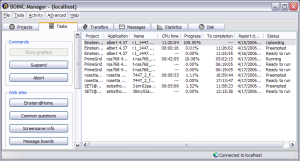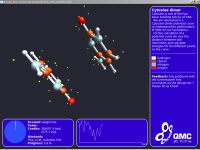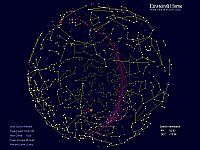Monday, October 29, 2007
ridiculousness and Trillian
I also cannot figure out how to use IRC with Trillian. There is supposed to be a built in feature, but I am not seeing it. I'm usually extremely good at finding things, assuming they are in fact there. My guess thus far is that it's a feature only available in Trillian Pro, which you have to pay for. I'm sorry, but I'm not paying for an IM program no matter how good it is. The only exception would be if it could teleport me.
Friday, October 26, 2007
BOINC
 BOINC: compute for science
BOINC: compute for scienceBOINC: compute for science

| BOINC is a program that lets you donate your idle computer time to science projects like SETI@home, Climateprediction.net, Rosetta@home, World Community Grid, and many others. After installing BOINC on your computer, you can connect it to as many of these projects as you like. Berkeley Open Infrastructure for Network ComputingFrom Wikipedia, the free encyclopediaThe Berkeley Open Infrastructure for Network Computing (BOINC) is a non-commercial middleware system for volunteer computing, originally developed to support the SETI@home project, but intended to be useful for other applications in areas as diverse as mathematics, medicine, molecular biology, climatology, and astrophysics. The intent of BOINC is to make it possible for researchers to tap into the enormous processing power of personal computers around the world. BOINC has been developed by a team based at the Space Sciences Laboratory at the University of California, Berkeley led by David Anderson, who also leads SETI@home. As a "quasi-supercomputing" platform, BOINC has over 430,000 active computers (hosts) worldwide processing on average 663 TFLOPS as of September 8, 2007.[1] BOINC is funded by the National Science Foundation through awards SCI/0221529, SCI/0438443, and SCI/0506411. The software is free/open source software, released under the GNU Lesser General Public License. It is also used for commercial usages, as there are some private companies that are beginning to use the platform to assist in their own research.The framework is supported by various operating systems: Windows (XP/2K/2003/NT/98/ME), Unix (Linux, FreeBSD) and Mac OS X. I have downloaded this, and it seems very cool so far. I haven't quite figured the entire thing out yet, but I am working on it. One of the projects I added was the SETI@Home project. I am pretty sure there is a way to see a star map, including your progress. Either way, anyone who likes science and owns a computer should download this. What have you got to lose? It's a good way to give back to the world of science. |
Thursday, October 25, 2007
Microshaft
My internet is being a piece of shit too. I'll be surprised if I can save this post without incident. I have had to hit refresh hundreds of times to actually get my school website to load properly.
The weather blows too. Literally. It's ridiculously windy out. It's also cold. I do not like the cold; I believe I am wrongly coloured, and should be black, and come from somewhere that is hot but not extremely sunny. I think I should be an albino west Indian. But, I am northern European, and appear so.
Tuesday, October 23, 2007
Are we not the only Earth out there?
 Howstuffworks "The Goldilocks Zone"
Howstuffworks "The Goldilocks Zone"Other Possible Earths
One of the main goals of planet hunting is to find exoplanets that have the characteristics of Earth and may consequently contain life. One of the keys to this search is the Goldilocks Zone. Also called the habitable zone or life zone, the Goldilocks Zone is an area of space in which a planet is just the right distance from its home star so that its surface is neither too hot nor too cold. That means that the planet could possibly host liquid water.
 Image courtesy NASA In surveying potential candidates for "new Earths," astronomers |
Few planets have been found in the Goldilocks Zone, but in April 2007, European astronomers announced the discovery of one. It was also, at that point, the most Earth-like planet ever found. The planet, called Gilese 581c, is 12,000 miles in diameter, or not much larger than Earth (8,000-mile diameter). It orbits a massive red star called Gilese 581, located in the Libra constellation, 20.5 light years from Earth. Gilese 581c orbits its star very closely, completing an orbit in just 13 Earth-days. This short orbit would make a planet too hot for life, except that Gilese 581's surface temperature is 1/50th that of our sun.
Because it lies in the Goldilocks Zone, Gilese 581c's surface temperature ranges from an estimated 32 degrees Fahrenheit to 102 degrees Fahrenheit. The research team that discovered it believes it has a developed atmosphere. The planet might not only have water -- it might be entirely covered by oceans.
Gilese 581c does have some things working against it. Its gravity is about twice as strong as Earth's, and it receives significant doses of radiation from its star. Both could inhibit life from developing. Even so, Gilese 581c is exciting not only for its Earth-like conditions, but also because of its relative proximity to Earth and its location in the elusive Goldilocks Zone.
As more powerful and precise telescopes go into space, future efforts will involve examining exoplanets' atmospheres for traces of oxygen and methane and looking for rocky planets that lie in the Goldilocks Zone. Scientists are also increasing their use of automated telescopes that are programmed to look for minuscule variations in a star's brightness caused by an orbiting planet passing in front of it. With a rapidly increasing pace of discovery of exoplanets and a practically infinite number of stars in the universe, many other exciting discoveries are ahead of us.
The ideal discovery would be a planet similar in composition to Earth that lies within the Goldilocks Zone and orbits a stable star. But it's important to keep in mind that popular depictions of extraterrestrial life are likely wrong. Some life forms may be no more advanced than bacteria. Others may be highly advanced but unrecognizable, a thought that has caused some scientists to advocate the search for so-called weird life.
For more information about Earth-like planets, planet hunting and related topics, please check out the links on the next page.
One of my friends happened to find this on howstuffworks.com and I thought it was pretty cool. I knew there was some range of distance in which planets would be habitable, I just didn't know it had a name.
science store
EfstonScience - The Science & Astronomy SuperStore

Canada's best selection of science & astronomy products!
Shop online or come visit our one-of-a-kind retail SuperStore in Toronto, Ontario packed with four floors and 8000 square feet of everything you want in smart science fun for the whole family!
Come inside and see the unwavering eScience brand of expert knowledge and professional service that we've provided North America since 1970!





